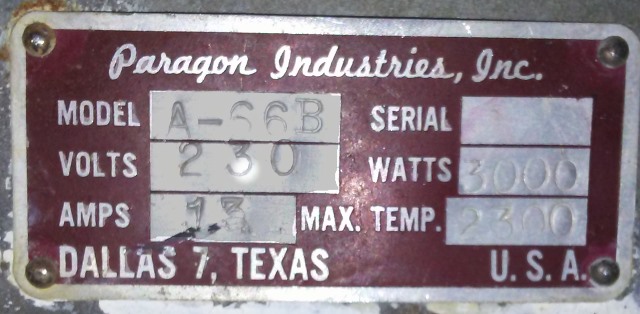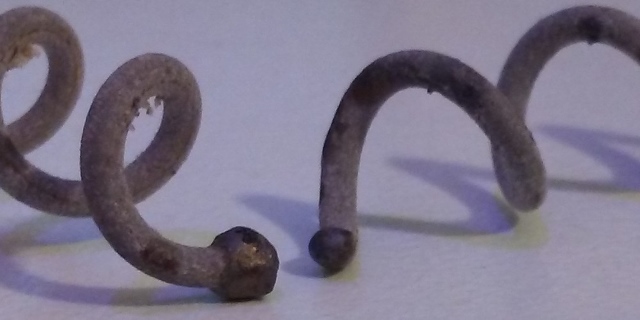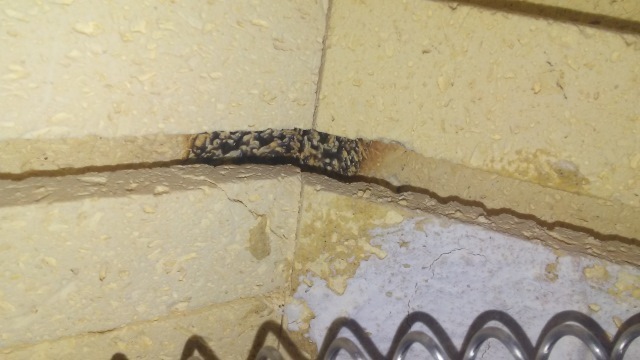Difference between revisions of "Kiln"
| Line 8: | Line 8: | ||
Kiln Setter Manual: http://www.evenheat-kiln.com/pdf/manual-c-kiln-sitter-with-limit-timer.pdf | Kiln Setter Manual: http://www.evenheat-kiln.com/pdf/manual-c-kiln-sitter-with-limit-timer.pdf | ||
| + | == A-66B == | ||
| − | The half is a Paragon A-A6-B stacked on top of a Paragon A-66-B, and it's terrible and broken. | + | The half is a Paragon A-A6-B stacked on top of a Paragon A-66-B, and it's terrible and broken. (it's fixed! Jury still out on terrible) |
| + | |||
| + | [[File:data_plate2.jpg]] | ||
Paragon's Instructions on measuring heating element resistance. | Paragon's Instructions on measuring heating element resistance. | ||
| Line 16: | Line 19: | ||
I don't know what our kiln's resistance *should* be, but the A-A6-B's coil read at 34.6Ω | I don't know what our kiln's resistance *should* be, but the A-A6-B's coil read at 34.6Ω | ||
| − | Late | + | Late December 2017, the lab received 2 factory-new elements from Paragon Industries for the A-66B. They each have a resistance of approximately 7.5Ω The values were hand-written on the packaging the elements arrived in, presumably after a factory test. Mechalich confirmed this is about right with a sparkfun multimeter, with one element reading about 0.3Ω less. |
We gotta do this: | We gotta do this: | ||
Revision as of 22:06, 29 January 2018
We have one and a half kilns.
The whole kiln is an Evenheat 6320-XL.
Kiln Manual: http://www.evenheat-kiln.com/pdf/manual-c-6320xl.pdf
Kiln Setter Manual: http://www.evenheat-kiln.com/pdf/manual-c-kiln-sitter-with-limit-timer.pdf
A-66B
The half is a Paragon A-A6-B stacked on top of a Paragon A-66-B, and it's terrible and broken. (it's fixed! Jury still out on terrible)
Paragon's Instructions on measuring heating element resistance. https://www.youtube.com/watch?v=nrUIdOTOJ48
I don't know what our kiln's resistance *should* be, but the A-A6-B's coil read at 34.6Ω
Late December 2017, the lab received 2 factory-new elements from Paragon Industries for the A-66B. They each have a resistance of approximately 7.5Ω The values were hand-written on the packaging the elements arrived in, presumably after a factory test. Mechalich confirmed this is about right with a sparkfun multimeter, with one element reading about 0.3Ω less.
We gotta do this: https://www.youtube.com/watch?v=7RPO1S4R5ag (Done!)
http://www.paragonweb.com/files/wiringdiagrams/A66WD.pdf
http://www.paragonweb.com/files/manuals/IM-5_A_&_B_Inst_&_Service_Manual_July2010.pdf
http://www.paragonweb.com/files/manuals/A_Series_Electrical.pdf
Axner's Supply[1] is 25 minutes from lab and will be a good local resource for supplies and repairs.
Element Failure Theory
Billions of years ago, microorganisms known as stromatolites evolved a defense mechanism allowing them to toxify the atmospheres of planets with a deadly poison: Oxygen. Where they thrived, other organisms were killed by elevated concentrations of this gas. While this new atmosphere allowed radical new metabolisms to exist, it sucks mad butt for exposed metallic surfaces which promptly oxidize. Beautiful, lustrous metallic crystals are oxidized to brittle, dull powders. Metal didn't even do anything wrong! Why stromatolites gotta be haters? So we grab Ed's knives, jump into the ocean, and carve these little buggers into extinction? Too late. Their photosynthetic legacy has doomed metal to be hidden beneath protective coatings. An unfortunate, added expense of using engineered materials on a biologically active planet.
Kiln elements begin to develop an oxide coating as soon as they are exposed to air. This oxidation reaction takes place rapidly at elevated temperatures, such as those found at normal operating temperatures inside a kiln. This oxide coating thickens with use and reduces the exposed surface area to our deadly, deadly atmosphere, slowing the process. With the continued thermal expansion and contraction of the metallic elements, this coating slowly flakes off, exposing more and more metal. This runaway reaction causes the resistance in the elements to increase with use and temperature.
Ultimately, a corroded section of the heating element fails. Mechalich observed if a section breaks while the element is hot, the hot metal begins thermionic emission creating a plasma that vaporizes the metal and briefly allows current to flow through the gap, melting the element further and leaving a glassy coating on the insulating firebrick until the plasma arc extinguishes. This phenomenon can be heard as a 60Hz buzz at the moment of failure.
Corners create hot-spots in the kiln where thermal failures happen first.
Mechanical failure of a corroded element is also possible. The oxidation of the elements leaves them brittle. Like a pretzel stick, it probably won't break under its own weight, but any attempt to bend it will result in a bad time. Only while the elements are red hot do they soften enough to be manipulated back into their grooves.



